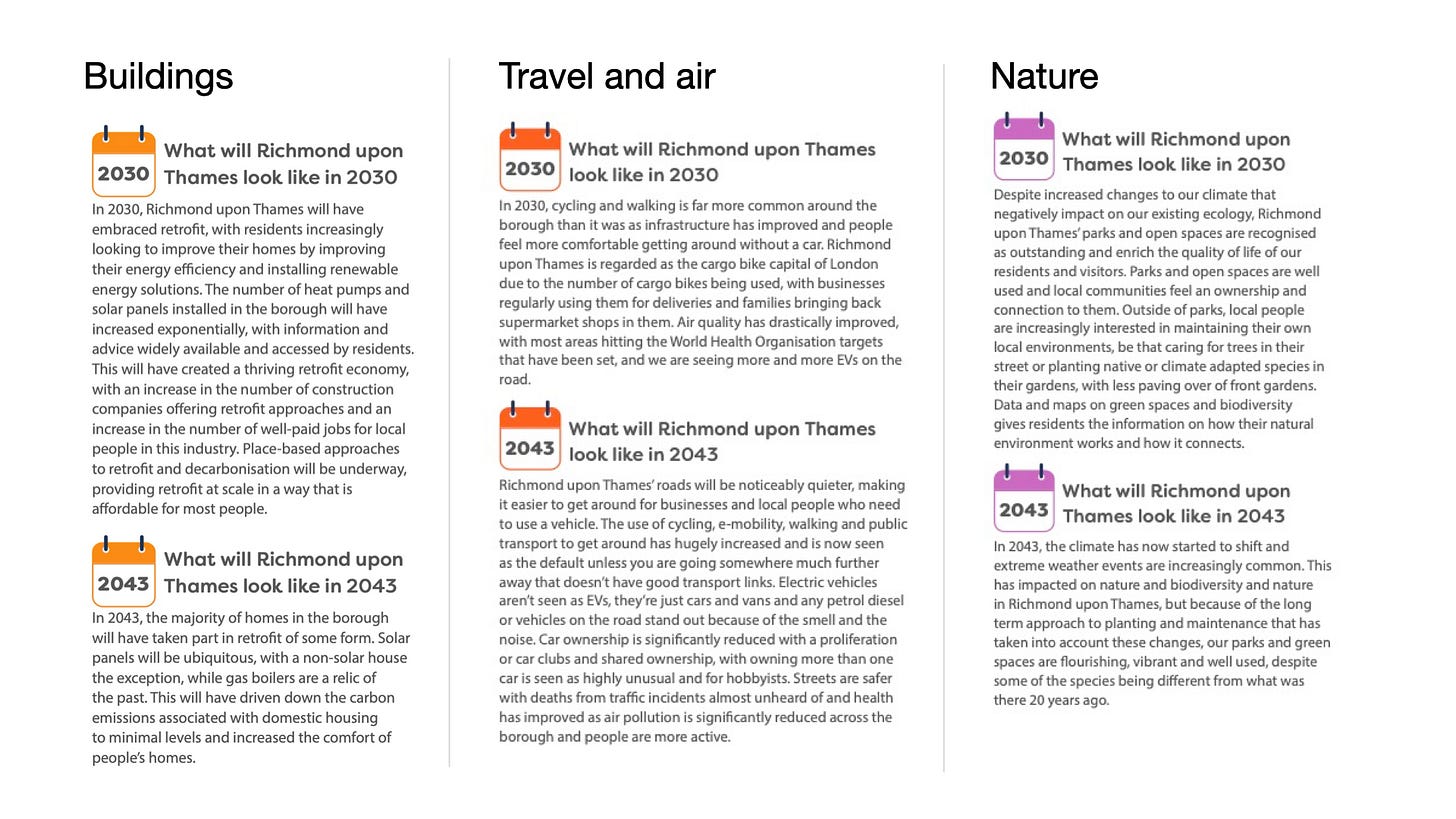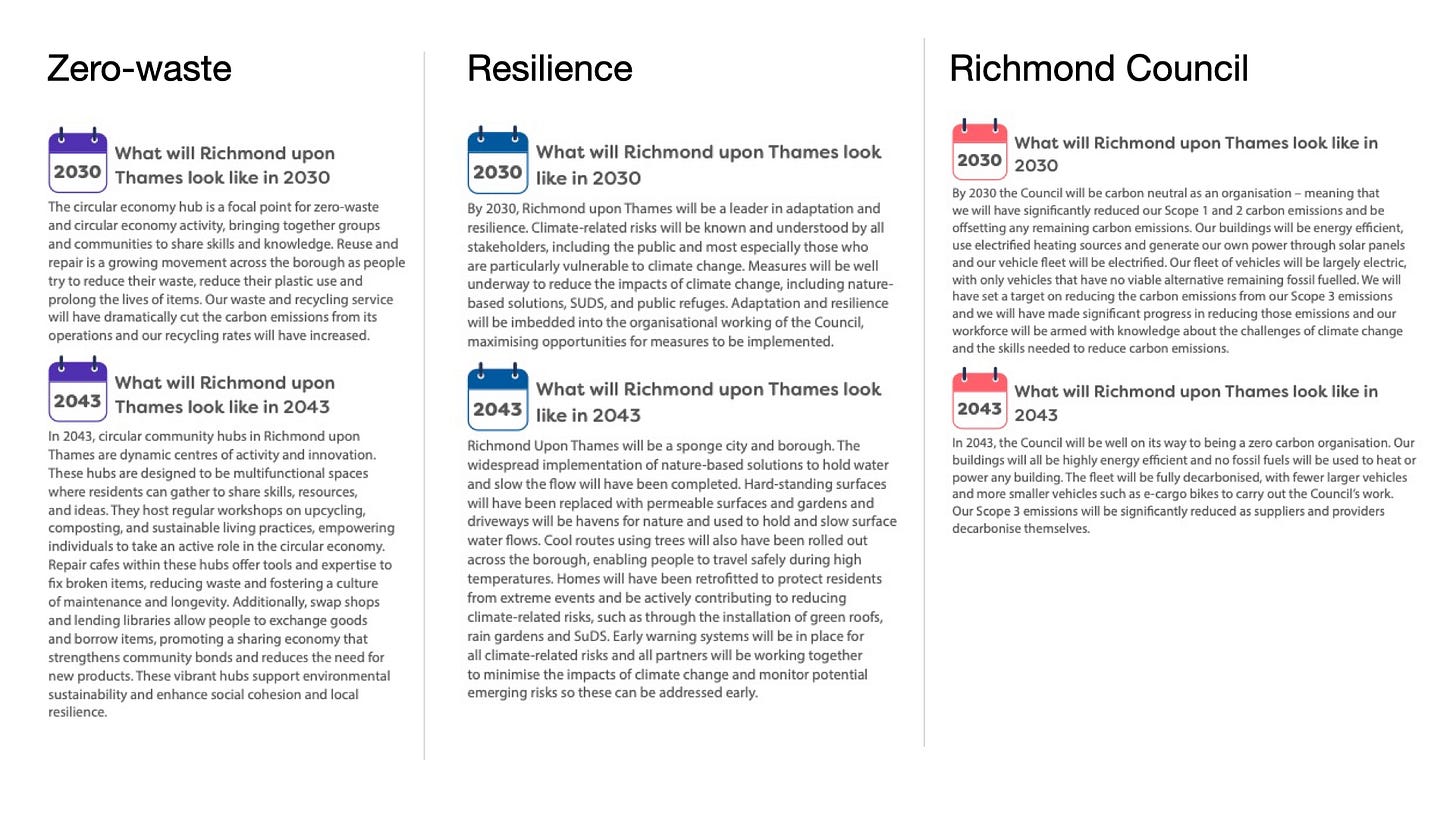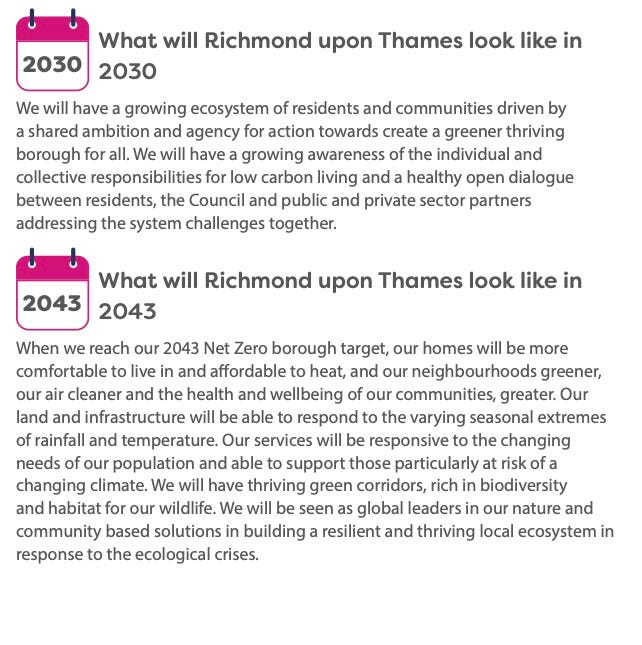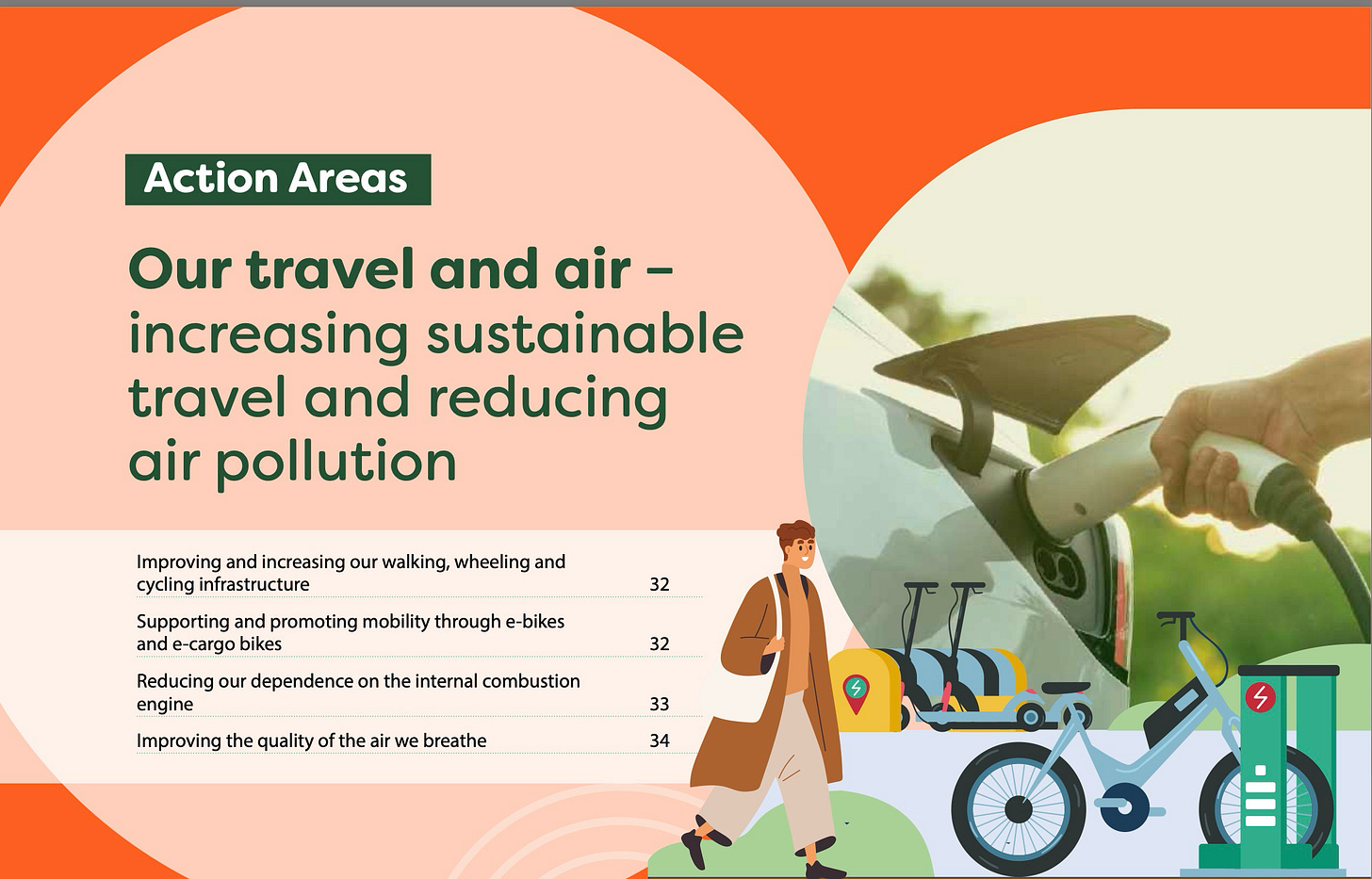How climate, one way or another, will change Richmond
Richmond Council has explained how life in the borough might feel different over the next 18 years because of the changing climate - Story 82
Climate change can be difficult to grasp, even when it hits familiar place such as Valencia, Spain or Athens, Greece. Even as the economic toll mounts, it is difficult to appreciate.
Enter Richmond Council.
It updated its climate change strategy
This document lays out how the borough could reach net zero carbon emissions by 2043—seven years ahead of the national UK target. It contains some good news. Emissions have decreased by around 50% between 2005 and 2022
(Incidentally, if sixty pages of technical strategy sounds daunting, an audio summary is available. Remember, you are listening to American AI bots, not humans)
This article is the first in a series exploring Richmond Council’s response to climate change. It is an introduction. There are planned follow-up features on specific issues.
This focus on the local is because although climate change is a global threat, any reaction must include changes to the things we can control. That is the focus of this blog.
To start this series, three highlights from the draft strategy:
a vivid description of life in Richmond if we don’t address climate change
useful future scenarios were the strategy to succeed
immediate reaction to the proposals
Richmond’s future climate
The draft strategy starts with a pithy description of the possible impact of borough’s climate. The do-nothing option makes grim reading.
Locally, Richmond upon Thames faces hotter, drier summers, warmer, wetter winters, and more extreme weather. We have seen rising temperatures and changing precipitation patterns, with future projections indicating further increases and vulnerable communities will be disproportionately affected.
Across the borough .. average annual temperatures have increased from 8.6°C 1890 to 12°C in 2022. Precipitation has significant annual variability, but overall summer precipitation has decreased and winter precipitation has increased.
These observed changes are expected to continue in future, with average annual temperatures projected to increase by up to 5.1°C by 2099 under a high emissions scenario; summer precipitation projected to decrease by up to 54.3% by 2099 under a high emissions scenario; and winter precipitation projected to increase by up to 27.5% by 2099 under a high emissions scenario.
In 2022, temperatures exceeded 40°C for the first time on record. This could be a normal summer by 2099.
With the River Thames flowing through the heart of the borough, flooding is a concern for residents.
Without action, climate change will have increasingly severe impacts, including flooding and heatwaves.
Future scenarios
The Council’s strategy to avoid the worst of these futures is divided into seven sections, including buildings, transport, air quality, and nature. Each one contains short descriptions—written in plain English—of how life in Richmond Borough, including Barnes and Mortlake might look and feel in 2030 and again in 2043.
These are very good.
These aren’t lofty aspirations. They’re grounded snapshots of daily life. The first three descriptions are listed below.
By 2043, the Council anticipates that most of Richmond’s c85,000 homes will have undergone retrofitting, potentially including rooftop solar panels or home insulation upgrades. The borough, the self-styled ‘cargo bike capital of London’, would have significantly quieter roads, better for delivery drivers, residents, and essential services alike. The climate itself will have changed, and we’ll be feeling it year by year.
‘Lead by example’ - the third of the columns above - is obvious, needs recognising and then supporting. You only have to remember the impact of one of our recent Prime Ministers who said one thing and did another.
Notes and thoughts
Credit to Richmond Council for painting a clear picture of what the future could look like. Setting out not only a 2043 net zero goal but also a more relatable milestone in 2030 is helpful. The strategy, taken as a whole, is thoughtful and well-constructed.
What follows should be read not as a criticism, but as a ‘yes, and…’. A call to build on strong foundations rather than start again.
Individual versus collective responsibility
One of the most important sentences in the document is in the seventh section, Our Communities. The 2030 and 2043 scenarios are highlighted below.
The borough boasts a rich ecosystem of community activity. Barnes and Mortlake is typical. Clubs outnumber SUVs. The council wants to nurture their growth to provide the necessary scale to deliver this strategy. It says by 2030,
We will have a growing awareness of the individual and collective responsibilities for low carbon living and a healthy open dialogue between residents, the Council and public and private sector partners addressing the system challenges together.
The idea of fostering both individual and collective responsibility is the correct one.
This is key to our future.
Richmond Council should do everything it can. But I wonder about how much progress it can make? The council points out on this one topic alone, emissions:
Local authorities are responsible for around 2% of emissions. However, the sphere of influence local authorities have is significant. As such, they can influence as much as a third of total emissions.
Assume they succeeed with better information, stronger support for community groups, and closer collaboration with local businesses. They are still a minor but significant player. The document calls out both the Mayor of London and the Greater London Assembly. They need to go further. Richmond Coucil needs to be in lock-step with them to have any chance of fulfilling its essential role in changing our culture.
Richmond’s distinctive emissions mix
I started this blog because of Hammersmith Bridge. Its closure was due in large part to climate change. One of the clearest arguments for keeping private cars off the bridge was their contribution to greenhouse gas emissions. In 2022, UK transport - including private cars - produced 28% of all emissions. The highest proportion ahead of buildings, 20% and Industry, 14%.
Richmond, however, tells a different story.
According to the borough’s strategy, transport including private cars, contributes around 24 per cent of local emissions. But the standout figure is housing: domestic buildings are responsible for an astonishing 46 per cent of Richmond’s total emissions.
At first glance, the disparity is confusing. National and local figures follow different classifications, which makes direct comparison tricky. But the contrast reflects something intuitive: the UK has agriculture, heavy industry and freight transport; Richmond does not. It is a residential borough with a built environment that carries a surprisingly heavy carbon load. These figures are not contradictory, then. They are simply answering different questions.
Yet the implications are clear. If Richmond is serious about reaching net zero, the role of housing cannot be a footnote. It must be as important as transport. This blog already treats housing as one of its nine core topics, although it has yet to feature. There were plans to shift the editorial focus from transport to housing later this year. These new figures justify that change.
Zero-waste vision not credible?
Among the seven scenarios, the circular economy vision is the least compelling. The ambition is spot-on
.. rather than making, using and then throwing stuff away (a linear system), a circular economy means looking at each of those stages for new ways of cycling materials and value back into the system – using materials and products again and again, in many different forms.
There’ll be better waste collection. Some of this will be persuading people, one household at a time. There’s a timely example of that from the Council minutes in February, earlier this year.
Keep Britain Tidy were contracted to provide an engagement team help residents reduce and recycle more food waste on low performing kerbside collection days, funded by the West London Waste Authority. 25,812 households were visited, and direct contact was made with 6,608 during November 2023 – February 2024. Of these, 58% said they used the food recycling service already. 59% of those that said they did not use the service stated an intention to start using it following the doorstep conversation and 858 caddies were delivered in response to requests received.
Run the numbers: 25,000 becomes 6,600 becomes 3,900 which becomes 858 caddies delivered. Over 195,000 people live in Richmond. Necessary work then, but hard.
Even more challenging is the emphasis is placed on the work of ‘circular community hubs’. One will be in place by 2030 and several by 2043. There’s a vivid description of a fully-formed network - the strategy calls this ‘community infrastructure’, with repair shops, lending libraries and swap shops. The council will enable residents and partner with businessness and organisations, such as charity shops on our high streets and Freecycle.co.uk, and its ilk online.
In some ways this is the most difficult change to make to our habits. Governments can regulate transport - Hammersmith Bridge is not open to cars. It can mandate future changes to to allow industry and retailers to adjust - there’s laws governing the sale of internal combustion engines over the next decade . But changing how someone approaches buying, say, clothes? That is almost entirely dependent on a deep and widely-adopted change in our culture.
It might be the most useful contribution Richmond Council can make is to be ready if and when society does change, with relevant services.
Transport vision suffers from car gap
This blog will focus later this year on housing but for now, the second vision - of cleaner air and low-traffic streets - is the priority.
Transport is only section in this Climate and Nature Strategy. It is reasonable to expect much more detail from the Transport Strategy when reaches a similar level of maturity later in its process. Until then, there are enough proposals to make some sort of assessment.
Put simply, this view of the future feels overly optimistic based on current proposals.
Roads dominated by emergency vehicles, buses and essential cars may be ideal. But getting there will require more than what’s being suggested to date. There bike-positive message is compelling: there needs to be much more car discouragement.




